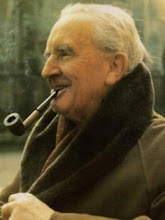
We come now to the longest of the great Lays about the Elder Days, the Narn i Chîn Húrin, or The Tale of the Children of Húrin. Incidentally, ''chîn'' is pronounced ''k-heen;'' you'll find in Unfinished Tales (the book from which I first read the tale in prose) the rather curious spelling ''Hîn'' - this was an editorial decision of Christopher Tolkien, which he later regretted, to prevent people from pronouncing the word like the modern English ''chin.'' I am not going to blog from The Silmarillion but rather from the recently published (well, if you count 2007 as recent) The Children of Húrin, which is far more detailed and coherent. When I brought this book, in the hardback first edition (with beautiful illustrations by Alan Lee), I was amazed that Tolkien was still being published in my lifetime (the 12 Volume The History of Middle-earth series was published by Christopher Tolkien from 1984-1996, but I was too young to remember those - or even if I could remember them, too young at any rate to appreciate them - they are very scholarly)!
First, I think we should establish some dates, something I have neglected too much in my hopelessly long synopsis of these days. The Narn is essentially the story of Túrin Turambar and his sister Nienor, the children of Húrin and Morwen. According to the Grey Annals Túrin was born ''in the winter of the year'', ''with omens of sorrow;'' that is, the 464th year after the first rising of the Sun, nine years after Morgoth broke the Siege of Angband in the Dagor Bragollach. The Nirnaeth Arnoediad took place in the spring of the 472nd year, when Túrin was 8 years old...I expect this sets the scene so far, if I think any more dates are required, I'll insert them in somewhere.

No comments:
Post a Comment